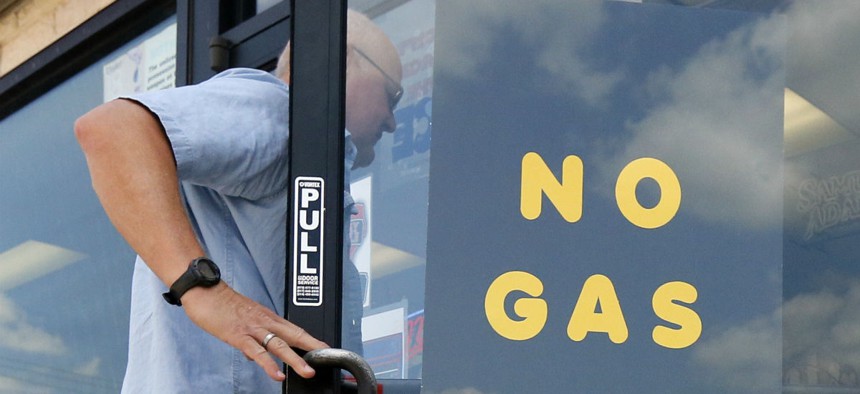
A customer walks into an Exxon filling station and convenience store on Aug. 31 in Bedford, Texas. Tony Gutierrez/AP
New Worries for Federal Fleet Managers: Rising Gas Prices, Assuming Gas Is Available
Gas prices are up because so much fuel comes from places where Harvey hit.
The effects of Hurricane Harvey are already showing up in U.S. gas prices. The record-setting storm barreled through the production chain that makes it possible for drivers all over the country to fuel up, from offshore oil platforms to gasoline pipelines.
On Wednesday, nearly 20 percent of oil production in the Gulf of Mexico was shut down, and roughly 30 percent of the country’s refining capacity was off, running at reduced rates, or at risk of being either of those, according research firm IHS Markit. The Colonial pipeline, which transports huge amounts of fuel from the gulf coast to New York, was out of service in the Texas refining hubs of Houston and Port Arthur. The Port of Houston, which takes in large amounts of oil and ships out large amounts of gasoline, was closed.
As a result, drivers around the country were on average paying 11 extra cents for a gallon of gas, according to GasBuddy, an app that crowdsources gas prices.

The gulf coast plays an outsized role in keeping the nation’s cars going. Harvey is the latest reminder of the dangers of concentrating such a big chunk of US refining capacity in a storm-prone area. It made landfall in Corpus Christi (five refineries, according to data from the US Energy Information Administration (EIA); proceeded to drop record amounts of rain in the Houston area (11), and then flooded Port Arthur and Beaumont (four).
The east coast, which has very little capacity to process oil into fuels, is particularly vulnerable to any storms along the gulf. (Hurricanes Katrina, Rita, Gustav, and Ike also upended gasoline production.) In 2014, nearly 60 percent of the fuel burned on the eastern seaboard came from the gulf coast, according to the EIA.
So drivers in cities such as Philadelphia, Charleston, and Miami: prepare for higher gas prices, if not disruptions in gas supplies. Here’s how they are faring so far:







